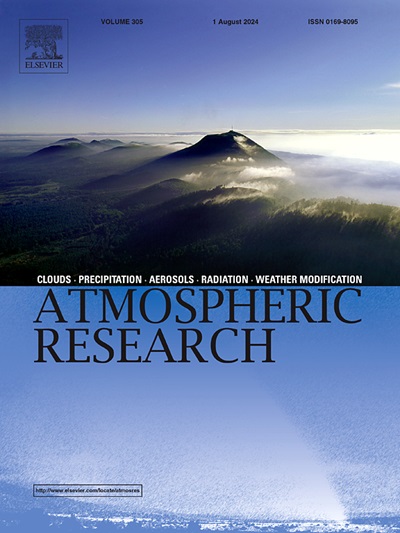利用改进的参数化方案估算青藏高原上空的全天空下沉长波辐射
IF 4.5
2区 地球科学
Q1 METEOROLOGY & ATMOSPHERIC SCIENCES
引用次数: 0
摘要
下潜长波辐射对全球能量循环至关重要。青藏高原以其独特的地理位置和极高的海拔高度,成为全球能源循环研究的热点。目前晴空条件下的DLR估算已经比较成熟,但专门估算全天条件下DLR的研究很少。此外,其中一些方法在TP上的空间分辨率和精度方面还有待改进。主要的挑战是云辐射效应和云下大气条件的不确定性。目前的参数化方案往往仅仅依赖于近地面气象参数和云的比例,这不足以表征云底和地面之间的热差异。此外,光学传感器受其穿透深度的限制,不能直接提供云基上的信息。综合卫星资料、气象强迫资料、再分析温度廓线和地表温度资料,同时考虑云下大气和云层本身的热辐射贡献,估算了TP上空的全天DLR。随着低云校正方案的引入以及在估算云下大气辐射贡献时纳入多个温度和湿度输入参数,这些改进进一步提高了精度。本研究的精度可与CERES-SYN相媲美,在任何时间尺度上的均方根误差都在30 W m−2以下,并且由于更高的空间分辨率,可以呈现更详细的空间变化。与现有DLR估计方案的比较表明,该研究无需使用预先获得的原位数据进行局部校准,即可获得更准确的结果。因此,该方法在全球范围内具有广泛的应用潜力,可以进一步提高DLR估计的精度。本文章由计算机程序翻译,如有差异,请以英文原文为准。
Estimation of all-sky downwelling longwave radiation over the Tibetan Plateau using an improved parameterization scheme
Downwelling longwave radiation (DLR) is crucial for the global energy cycle. The Tibetan Plateau (TP) is a focal point in global energy cycle research owing to its distinct geographical position and remarkably high elevation. At present, the DLR estimates under clear-sky conditions are relatively mature, but only a few studies have specifically estimated the DLR under all-sky conditions. Moreover, some of these methods still need to be improved with regard to spatial resolution and accuracy when applied over the TP. The primary challenge is the uncertainty of cloud radiation effects and the atmospheric conditions beneath the clouds. Current parameterization schemes often rely solely on near-surface meteorological parameters and the cloud fraction, which are insufficient for characterizing the thermal differences between the cloud base and the surface. Additionally, optical sensors are limited by their penetration depth and cannot directly provide information on the cloud base. By combining satellite data, meteorological forcing data, reanalysis temperature profiles, and land surface temperature datasets and simultaneously considering the thermal radiation contributions from both the atmosphere below clouds and the cloud layer itself, the all-sky DLR over the TP was estimated. With the introduction of a low-cloud correction scheme and the incorporation of multiple temperature and humidity input parameters when estimating the radiation contribution from the atmosphere below clouds, these improvements further enhance the accuracy. The precision of this study is comparable to that of CERES-SYN, with RMSEs below 30 W m−2 at any timescale, and more detailed spatial variations can be presented due to the higher spatial resolution. A comparison with existing DLR estimation schemes shows that this study achieves more accurate results without the need for local calibration with preobtained in situ data. Therefore, this method shows the potential for application across various regions globally to further improve the precision of DLR estimation.
求助全文
通过发布文献求助,成功后即可免费获取论文全文。
去求助
来源期刊

Atmospheric Research
地学-气象与大气科学
CiteScore
9.40
自引率
10.90%
发文量
460
审稿时长
47 days
期刊介绍:
The journal publishes scientific papers (research papers, review articles, letters and notes) dealing with the part of the atmosphere where meteorological events occur. Attention is given to all processes extending from the earth surface to the tropopause, but special emphasis continues to be devoted to the physics of clouds, mesoscale meteorology and air pollution, i.e. atmospheric aerosols; microphysical processes; cloud dynamics and thermodynamics; numerical simulation, climatology, climate change and weather modification.
 求助内容:
求助内容: 应助结果提醒方式:
应助结果提醒方式:


